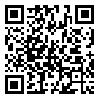Tue, Dec 2, 2025
Volume 31, Issue 4 (9-2021)
JHNM 2021, 31(4): 219-226 |
Back to browse issues page
Download citation:
BibTeX | RIS | EndNote | Medlars | ProCite | Reference Manager | RefWorks
Send citation to:



BibTeX | RIS | EndNote | Medlars | ProCite | Reference Manager | RefWorks
Send citation to:
Mossayebnezhad R, Niknami M, Pakseresht S, Kazemnezhad Leili E. Estimation of Fetal Weight by Clinical Methods and Ultrasonography and Comparing With Actual Birth Weight. JHNM 2021; 31 (4) :219-226
URL: http://hnmj.gums.ac.ir/article-1-1737-en.html
URL: http://hnmj.gums.ac.ir/article-1-1737-en.html
1- Instructor, Department of Midwifery, School of Nursing and Midwifery, Zanjan University of Medical Sciences, Zanjan, Iran.
2- Instructor, Department of Midwifery, School of Nursing and Midwifery, Guilan University of Medical Sciences, Rasht, Iran. ,niknami@gums.ac.ir
3- Professor, Social Determinants of Health Research Center (SDHRC), Reproductive Health Research Center, Department of Obstetrics, Women Health Promotion, School of Nursing and Midwifery, Guilan University of Medical Sciences, Rasht, Iran.
4- Associate Professor, Department of Biostatics, School of Nursing and Midwifery, Guilan University of Medical Sciences, Rasht, Iran.
2- Instructor, Department of Midwifery, School of Nursing and Midwifery, Guilan University of Medical Sciences, Rasht, Iran. ,
3- Professor, Social Determinants of Health Research Center (SDHRC), Reproductive Health Research Center, Department of Obstetrics, Women Health Promotion, School of Nursing and Midwifery, Guilan University of Medical Sciences, Rasht, Iran.
4- Associate Professor, Department of Biostatics, School of Nursing and Midwifery, Guilan University of Medical Sciences, Rasht, Iran.
Abstract: (2075 Views)
Introduction: Assessment of fetal weight is a vital factor in antenatal care, not only in the management of labor and delivery but also in identifying fetal weight disorders.
Objective: This study compares the accuracy of clinical methods and ultrasonography in Estimating Fetal Weight (EFW) with Actual Birth Weight (ABW) in term pregnant women.
Materials and Methods: This diagnostic test evaluation study was performed on 247 single-term pregnant women admitted to an educational, therapeutic hospital in Rasht City, Iran. In this study, abdominal palpation, Johnson’s formula, Insler’s formula, and ultrasonography were used to estimate fetal weight. One-sample t-test, the Chi-square, and the Bland-Altman plot were used to compare the diagnostic value of fetal weight estimation methods. The accuracy of tests was estimated based on sensitivity and specificity in fetal weight groups (below 2500 g, 2500- 4000 g, and above 4000 g) by the Bland-Altman plot.
Results: The participating pregnant women had a Mean±SD age of 28.86±4.24 years, body mass index of 32.98±6.0 kg/m2, and gestational age of 39±1.04 wk. Their Mean±SD actual birth weight was 3343.352±432.799 gr, Also, the Mean±SD birth weight found by abdominal palpation was 3371.053±345.561 gr, Mean±SD birth weight by Johnson’s formula 3041.206 ±411 gr, by Insler’s formula 3556.316±531.567 gr, and by ultrasonography 3294.28±380.09 gr, Based on the one-sample t-test, the abdominal palpation had the lowest (P=0.261), and the Insler’s formula (P=0.001) had the highest difference with the actual birth weight. Regarding the fetal weight groups, Insler’s formula (96.33%) was highly accurate in Low Birth Weight (LBW), but abdominal palpation (91.09%) was more accurate in normal weight and macrosomia (94.72%) groups. There was a significant difference between clinical methods with ABW (P=0.026).
Conclusion: Clinical methods are accessible, affordable, and available and can estimate fetal weight in developing countries, especially in our country.
Objective: This study compares the accuracy of clinical methods and ultrasonography in Estimating Fetal Weight (EFW) with Actual Birth Weight (ABW) in term pregnant women.
Materials and Methods: This diagnostic test evaluation study was performed on 247 single-term pregnant women admitted to an educational, therapeutic hospital in Rasht City, Iran. In this study, abdominal palpation, Johnson’s formula, Insler’s formula, and ultrasonography were used to estimate fetal weight. One-sample t-test, the Chi-square, and the Bland-Altman plot were used to compare the diagnostic value of fetal weight estimation methods. The accuracy of tests was estimated based on sensitivity and specificity in fetal weight groups (below 2500 g, 2500- 4000 g, and above 4000 g) by the Bland-Altman plot.
Results: The participating pregnant women had a Mean±SD age of 28.86±4.24 years, body mass index of 32.98±6.0 kg/m2, and gestational age of 39±1.04 wk. Their Mean±SD actual birth weight was 3343.352±432.799 gr, Also, the Mean±SD birth weight found by abdominal palpation was 3371.053±345.561 gr, Mean±SD birth weight by Johnson’s formula 3041.206 ±411 gr, by Insler’s formula 3556.316±531.567 gr, and by ultrasonography 3294.28±380.09 gr, Based on the one-sample t-test, the abdominal palpation had the lowest (P=0.261), and the Insler’s formula (P=0.001) had the highest difference with the actual birth weight. Regarding the fetal weight groups, Insler’s formula (96.33%) was highly accurate in Low Birth Weight (LBW), but abdominal palpation (91.09%) was more accurate in normal weight and macrosomia (94.72%) groups. There was a significant difference between clinical methods with ABW (P=0.026).
Conclusion: Clinical methods are accessible, affordable, and available and can estimate fetal weight in developing countries, especially in our country.
Article Type : Applicable |
Subject:
Special
Received: 2021/08/11 | Accepted: 2021/08/29 | Published: 2021/01/1
Received: 2021/08/11 | Accepted: 2021/08/29 | Published: 2021/01/1
Send email to the article author
| Rights and permissions | |
 | This work is licensed under a Creative Commons Attribution-NonCommercial 4.0 International License. |






